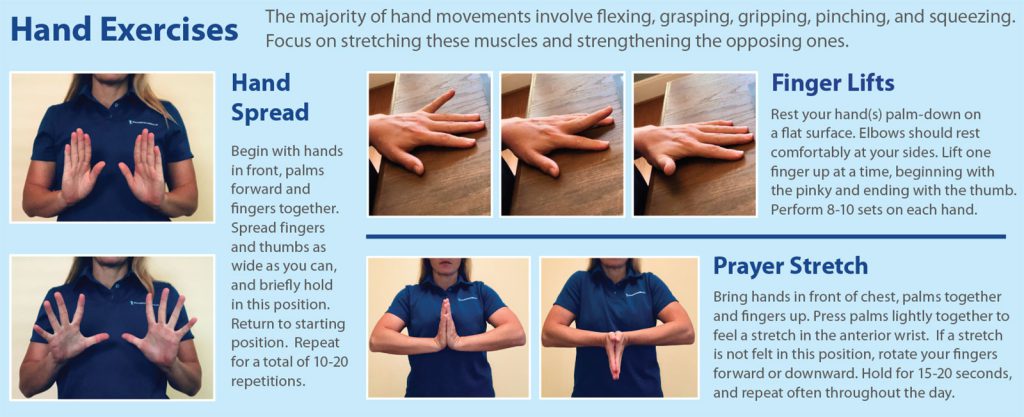Why does it hurt so much?
The carpal tunnel is a small space at the wrist in which the median nerve and nine tendons pass through. The median nerve travels on top of the tendons through the tunnel. The tunnel itself is made up of your wrist bones and along the top of the tunnel is a thick fibrous ligament called the transverse carpal ligament. If the tendons become swollen (tenosynovitis) or if the tunnel size itself decreases because of injury, compression to the median nerve can occur.
What is Carpal Tunnel Syndrome (CTS)?
CTS, also known as median nerve compression, occurs due to prolonged pressure on the median nerve as it passes through the carpal tunnel. The median nerve controls movement and feeling in our first 3 fingers (thumb, index, middle). When this nerve is compressed, numbness, tingling, burning, and/or weakness occur in the palm and any of these 3 digits. Symptoms of CTS may include: pain during pinching and gripping, a feeling of clumsiness – the inability to hold things, numbness in the fingers at night, or a radiating pain up the arm.
Risk factors at home and at work.
There are many factors that can contribute to pain in the carpal tunnel, but these are some of the most common causes of CTS.
- Repetition – Overuse can occur with light forces. Irritation of the tendon can be caused by rapid, repetitive activity without a break. Decreased blood flow to the nerves and tendons may be caused by holding or gripping an object without relaxation.
- Force – The muscles of the hand and fingers are contracted when gripping or pinching. These contractions place stress on the tendons that go through the carpal tunnel. Higher forces are more likely to expose you to greater risks.
- Bending – The tendons in the carpal tunnel can be irritated by bending your hand. Bending your hand up, down, or sideways may inflame the tendons in the carpal tunnel.
- Vibration – Nerves are especially susceptible to vibration. Common causes of vibration of the nerves in the carpal tunnel are power tools, steering wheels, or other mechanized equipment.
- Impact – Your hand is not a tool. Hitting, moving, or jerking objects may damage the structures of the wrist. Even using a hammer transmits sudden force to these delicate structures.
- Anatomy –Some are born with smaller carpal tunnels, which may increase susceptibility to developing CTS.
- Certain Medical Conditions – Medical conditions such as diabetes, hypothyroidism, rheumatoid arthritis, pregnancy, appear to increase CTS risk.
- Obesity and Overweightness – Weight issues can increase CTS risk, possibly due to increased pressure on the carpal tunnel and median nerve.

Practicing prevention.
The first line of defense against Carpal Tunnel Syndrome is reducing the risk factors that may lead to CTS. Look carefully at your equipment and tools and try to eliminate the forces that are risk factors. This can include bending, vibration, impact, and repetition.
- Tool handles – A handle should have an optimum grip span of about 2 ¼ inches.
- Gripping surface – Use rubberized coating or tubing on your gripping surface. This will lower the grip strength required to hold onto the tool.
- Reduction in vibration – Place a rubber or gel material on the handles or utilize gloves with rubber inserts to reduce vibration.
- Ice – Use an ice pack on the palm and wrist area for 10 minutes after intensive hand activities. This can be followed by the wrist stretches and and hand exercises shown.
- Rest – Rest your hands after frequent, forceful, or repetitive activities that last 30-60 minutes. Try doing a different activity which is not as stressful to your wrist and hand.

People with early symptoms of CTS may find relief by shaking out their hands. Night splints can be worn to keep the wrist neutral while at sleep, relieving pressure on the median nerve. When and if the condition progresses, muscles in the hand are affected and grip strength may decrease. The use of proper posture techniques and self-care can help significantly, especially when begun early.
©2023HealthSpot References: (1) American Academy of Orthopaedic Surgeons. (2020). Carpal tunnel syndrome. https://orthoinfo.aaos.org/en/diseases–conditions/carpal-tunnel-syndrome (2) National Institute of Neurological Disorders and Stroke. (2021).

